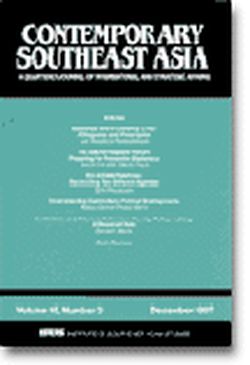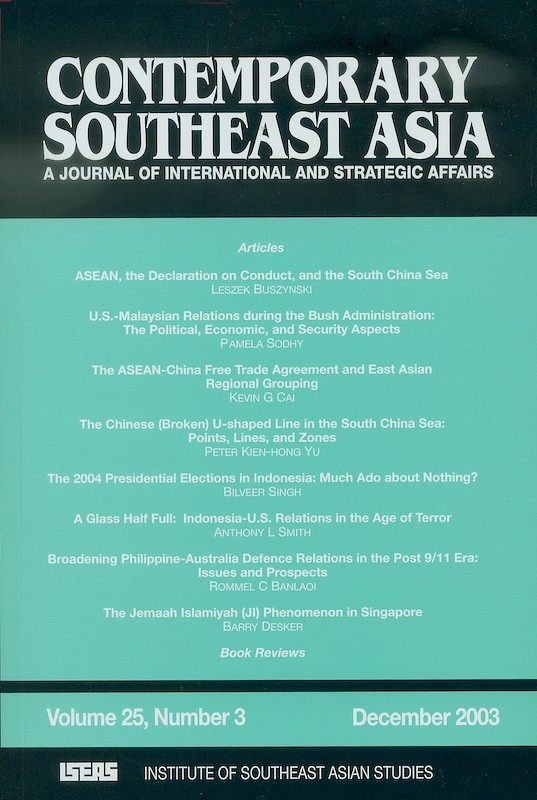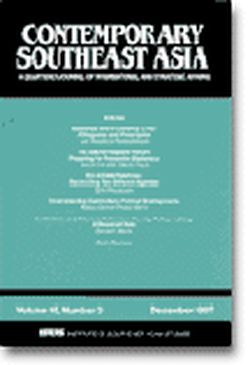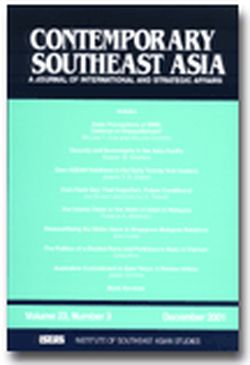Contemporary Southeast Asia: A Journal of International and Strategic Affairs Vol. 22/2 (Aug 2000)

Date of publication:
October 2000
Number of pages:
195
Code:
CS22/2
About the publication
An internationally refereed journal that specializes in the politics, international relations and security-related issues of Southeast Asia and the Asia-Pacific.
Contents
-
Preliminary pages
-
1. East Asia: Prospects for the New Decade, by Peter W Preston , author see abstractAn analysis of contemporary dynamics of change within East Asia, cast in terms of the resources of the classical European tradition of social theorizing, suggests that three intermeshing logics of change are shaping the fundamental structural underpinnings of current events: the long-established drive for industrial-capitalist modernity, the now familiar concern for regional interchanges and the very recent unexpected episode of the Asian financial crisis. Developments within the region will involve, crucially: (a) Japan, where one can expect few novel initiatives; (b) China, where one might expect processes of reform to continue; (c) the NIEs, where there is likely to be deepening interest in the region; and (d) the ASEAN states, where there would probably be a greater concern for developments within the wider East Asian region. Overall, the regional states are likely to continue to develop in line with specific historically established logics of change.
-
2. ASEAN's Relations with Major External Powers, by N Ganesan, author see abstractThe international relations of Southeast Asia has traditionally been determined by external powers. During the Cold War until the conclusion of the Second Indochina War in 1975, the United States had overwhelming influence on the ASEAN states. Between 1975 and 1989, ASEAN achieved greater accommodation with China to address Thai security concerns. Since 1989, ASEAN has been relatively free of external power entanglements. Preliminary evidence from the past indicates a generally favourable appraisal of the United States and Japan and a more cautious attitude towards China. ASEAN's new latitude in managing its own affairs is complicated by its membership expansion and internal disagreements. However, ASEAN's manifest desire is that the major external powers will provide a favourable regional environment for peace and development.
-
3. ASEAN as a Neighbourhood Watch Group, by Khoo How San, author see abstractThe Secretary-General of ASEAN, Rodolfo Severino, had said that the organization has to be measured against the purposes that it has set for itself and the limitation that it has imposed upon itself. This article argues that ASEANs core purpose is that of an intergovernmental neighbourhood watch group, its primary function being that of ensuring regional political and economic stability. The neighbourhood watch group (NWG) idea borrows from the police-community crime prevention concept. When applied to ASEAN, this idea draws attention to its members self-interest and mutual stake in regional stability. With the end of the Cold War, ASEAN embarked on expansion and consolidation, and seemed to have co-opted the newer members into this idea. Since 1997, however, ASEANs fundamental purpose has been severely tested and it remains to be seen if the grouping can meet the challenge.
-
4. The Reform of the Indonesian Armed Forces, by Damien Kingsbury, author see abstractIndonesia's armed forces have played a dominant role in domestic politics from 1957 under their so-called dual function. While the armed forces consolidated in the early Soeharto period, a significant faction later came to challenge his authority, contributing to his resignation from the presidency. This marked the beginning of the armed forces reform movement, and its transition away from the political arena. Despite its reform orientation, under the Habibie presidency the armed forces were a stronger (and united) political actor. This carried over into the presidency of Abdurrahman Wahid. However, as a consequence of the reform movement within the armed forces and with the assistance of Abdurrahman, the armed forces have splintered into several factions. This factionalism has given greater strength to the reform movement within the armed forces, and may contribute to the strengthening of democracy in Indonesia.
-
5. Tokyo's Dynamic Diplomacy: Japan and the Subcontinents Nuclear Tests, by Satu Limaye, author see abstractAmong Japan's recent international initiatives, its responses to India's and Pakistan's nuclear tests have been largely overlooked. Major Japanese diplomatic initiatives in the wake of these tests included promoting nuclear non-proliferation and disarmament and taking a leadership role in resolving the India-Pakistan dispute. Japans energetic responses were driven by domestic considerations of public opinion, coalition politics, and bureaucratic interests. Externally, Japan was motivated by a desire to highlight its contributions to international peace and security, solidify its claims to a permanent United Nations Security Council seat, and exhibit its commitment to nuclear non-proliferation, as well as by the relative paucity of concrete interest in India and Pakistan. However, Japan achieved few of its objectives. A repeat of such episodes may well influence Japans future efforts to be more active in international affairs.
-
6. The Politics of Privatization in the Malaysian Health Care System, by Simon Barraclough, author see abstractDespite a strong commitment, for both ideological and pragmatic reasons, to the privatization of state enterprises and services, and pronouncements that public health care services would be privatized, the Malaysian Government has introduced only a selective degree of privatization in the health sector. Haemodialysis, pharmaceutical distribution and hospital support services have been transferred to the private sector. Several privatized entities have links with the dominant party in the ruling coalition government. Moves to privatize public hospitals have politicized health care policy in Malaysia and generated opposition from interest groups and demands for greater public consultation in policy-making. Both political and practical factors have restrained the government from introducing wider privatization policies within the health sector.
-
7. The Political Economy of Vietnam's Transformation Process, by Quan Xuan Dinh, author see abstractReforms started by Vietnam in 1986 are far from complete. As a result of a slowdown in economic growth, growing unemployment, and social unrest, Vietnam faces renewed challenges for further reform. With doi moi (renovation) there has been greater openness and mounting pressure for more open discussions within the Communist Party of Vietnam (CPV). The country faces two options: to continue with the same pace of change and risk falling economically behind neighbouring countries, or to undertake more radical economic reform and risk losing control. This article explores the economic decision-making process in Vietnam. It argues that gradualism in reform is due to internal strife, to a trial-and-error approach, and to the lack of capable human resources. Evidence suggests that prescription for economic reforms cannot be carried out effectively without modernizing the CPVs political decision-making process.
-
8. New Zealand and Asia-Pacific Security: New Rationale for Engagement?, by Robert Ayson, author see abstractThroughout the 1990s, New Zealand maintained a commitment to Asia-Pacific security as one of the three pillars of a broadly based defense policy. However, Wellington tended to define its regional security goals in very general terms, making few obvious steps towards the formal publication of a regional security strategy. This article provides an explanation for this somewhat indirect approach to regional security. It also explores New Zealand's future role in Asia-Pacific regional security against the backdrop of two important developments in the latter half of 1999. The first of these was New Zealand's extensive commitment to the multinational force in East Timor the largest overseas deployment by the New Zealand Defense Force since the Korean War. The second was the election of a centre-left Labour-Alliance government committed to a thorough review of New Zealand's defense priorities.
- BOOK REVIEWS
-
BOOK REVIEW: The U.S.-Japan Alliance: Past, Present and Future. Edited by Michael J. Green and Patrick M. Cronin., by Francis Quek Hong Chye, author
-
BOOK REVIEW: Rethinking Geopolitics. Edited by Gearoid O. Tuathail and Simon Dalby., by John Garofano, author
-
BOOK REVIEW: Statecraft and Security: The Cold War and Beyond. Edited by Ken Booth., by Robin Ramcharan, author
-
BOOK REVIEW: Indonesian Politics in Crisis: The Long Fall of Suharto, 1996-98. By Stefan Eklof., by Meredith L Weiss, author
-
BOOK REVIEW: Authority Relations and Economic Decision-making in Vietnam: An Historical Perspective. By Dang Phong and Melanie Beresford.






